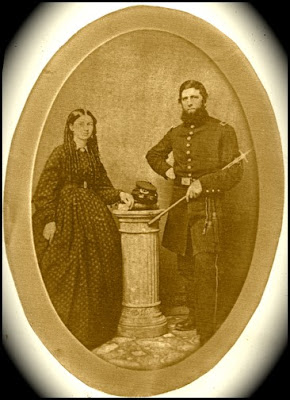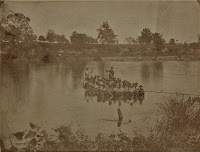 |
| Dr. Kurtz and wife Sarah 1861 Courtesy of Eleanor Hancock |
Kurtz replaced Surgeon John B. Laidley of Carmichaels, Greene County, who was medically discharged from the 85th Pennsylvania in May of 1862.
In the photo, Kurtz is proudly dressed in his uniform including his officer's sword. Years later,
 |
| LOC |
Kurtz lost a prized sword, but later, acquired an even more precious possession. When the men in the 85th Pennsylvania were winding down their three-year enlistment in the fall of 1864, they pooled their money and bought a complete surgeon kit in an engraved chest for Dr. Kurtz. It was one of his proudest possessions for the remainder of his life. It was a striking gesture for the man who cared for them when they were wounded, sick and for many, on their deathbeds. It was somewhat ironic because Kurtz was from eastern Pennsylvania, unlike most of the regiment than hailed from the southwestern corner of the state.
 |
| Reading Times 1-2-1865 |
The presentation of the gift was chronicled in a Reading, PA newspaper shortly after Kurtz returned home from the war in early 1865.
Kurtz was born on September 27, 1832 in Chester County, PA. He graduated from Jefferson Medical College in Philadelphia in 1854. Prior to the war he practiced medicine in Phoenixville (Chester County) and Oakland Mills (Juniata County). He settled in Reading (Berks County) and practiced medicine there for 40 years. In 1891, he was elected as the president of the Pennsylvania State Medical Society.
 |
| Gift Medical Chest of Dr. Samuel L. Kurtz On the right is Kurtz' granddaughter Georgeine Gruver Reading Eagle 2-19-1967 p.44 |
During the Civil War, Kurtz was involved in a bizarre battlefield incident that resulted the the death of musician Lemuel Thomas. It occurred on the first day of the regiment's six-day mission near Richmond in which they fought at Second Deep Bottom.
Musicians often served as doctor's assistants during a fight. As described by 85th Pennsylvania historian Luther S, Dickey, “Musician Lemuel Thomas of Company C, was on duty with Surgeon Kurtz of the Regiment assisting in caring for the wounded. Surgeon Kurtz was standing with an arm resting against a tree when a cannon ball from a battery of the enemy ricocheted, striking the heel of his shoe and then bounded to the head of Musician Thomas, fracturing his skull from which he died the following day. Although painfully wounded by the enemy's missile Surgeon Kurtz remained on duty.” [Dickey, History of the 85th Regiment Pennsylvania Volunteer Infantry, p. 377]
The 24-year old Thomas was from Fayette City, Fayette County. He is buried in the Hampton (VA) National Cemetery.
Kurtz was later involved in helping the wounded at the Battle of Darbytown Road near Richmond on October 13, 1864. By this point in the war, according to the following account by Dr. Charles Clark of the 39th Illinois, Kurtz and other surgeons of their brigade were moved close to the battlefield to provide more immediate care to the wounded. Both the 85th Pennsylvania and the 39th Illinois were part of the First Brigade of Colonel Francis B. Pond during the battle. The 85th Pennsylvania suffered only a few wounded at Darbytown Road but losses by the rest of their brigade were in the hundreds.
 Dr. Clark wrote, "The writer’s experiences at this battle [Darbytown Road] were
unusually disagreeable…On the morning of the 13th [of October], he
with other surgeons of the First Division of the Tenth Corps were ordered by
the Medical Director to take the field and follow the command with strict
orders to keep within 300 yards of the line of battle. When the First Brigade
were preparing and forming to assault the rebel redoubt, he took the position
behind a corn-crib in the yard of the Gerault house. As the Brigade advanced,
there was a painful hush, like that of an audience awaiting some terrible
denouement. Then came the roar and rattle of guns and a rain of shell and
grapeshot in a most careless manner, shattering the old crib and scattering
splinters and debris in all directions. One ambulance horse was killed and the
driver wounded, and much other damage done. The wounded soon came back in
numbers…Finding our position untenable, we felt justified in transgressing
orders and removed to the left and rear inside an old earthwork where at last
we could give our undivided attention to our work without fear of being either
killed or wounded. The wounded…were sent back to the corps hospital some three
miles distant." [Clark, Yates Phalanx, p. 179]
Dr. Clark wrote, "The writer’s experiences at this battle [Darbytown Road] were
unusually disagreeable…On the morning of the 13th [of October], he
with other surgeons of the First Division of the Tenth Corps were ordered by
the Medical Director to take the field and follow the command with strict
orders to keep within 300 yards of the line of battle. When the First Brigade
were preparing and forming to assault the rebel redoubt, he took the position
behind a corn-crib in the yard of the Gerault house. As the Brigade advanced,
there was a painful hush, like that of an audience awaiting some terrible
denouement. Then came the roar and rattle of guns and a rain of shell and
grapeshot in a most careless manner, shattering the old crib and scattering
splinters and debris in all directions. One ambulance horse was killed and the
driver wounded, and much other damage done. The wounded soon came back in
numbers…Finding our position untenable, we felt justified in transgressing
orders and removed to the left and rear inside an old earthwork where at last
we could give our undivided attention to our work without fear of being either
killed or wounded. The wounded…were sent back to the corps hospital some three
miles distant." [Clark, Yates Phalanx, p. 179]After the war, upon reestablishing his practice in Reading, Kurtz won the trust of local residents when he treated a group of children involved in an accidental explosion. A group of boys were playing with gunpowder at a canal near his office when the explosion occurred. Kurtz treated their injuries effectively and the new doctor won the trust of his neighbors.
Kurtz married Sarah Morgan in 1854. Together they had two sons and a daughter. His two sons, Julius and Clarence, also became doctors. (Morton Montgomery, Biographies from Historical and Biographical Annals, p.399)
Kurtz died on April 21, 1921 at the age of 88. He had practiced medicine for 60 years. At the time of his death, he was the oldest practicing physician in Reading. He is buried in the Charles Evans Cemetery in Reading.
